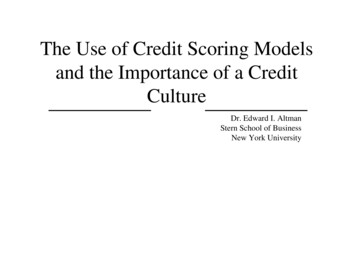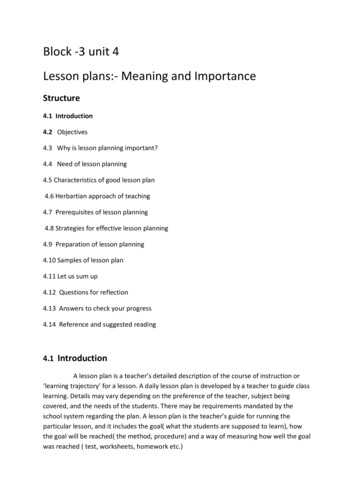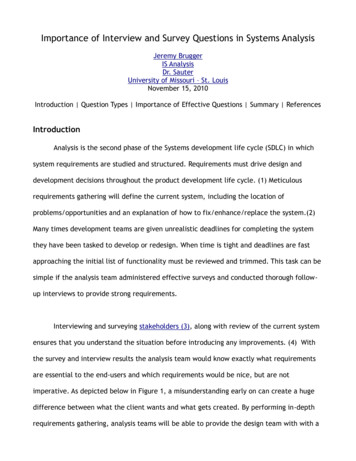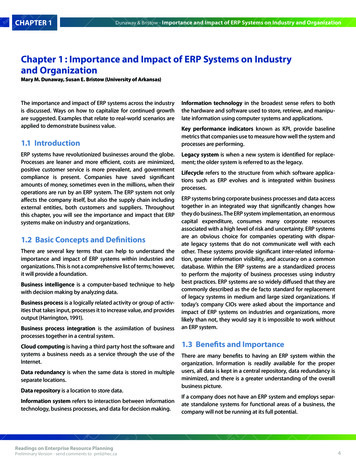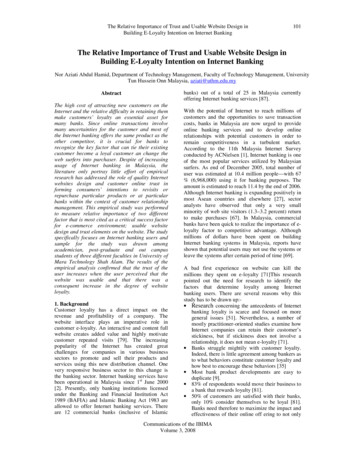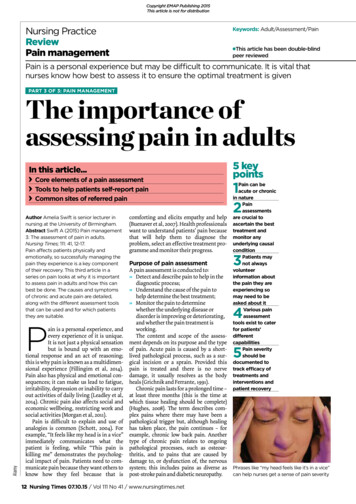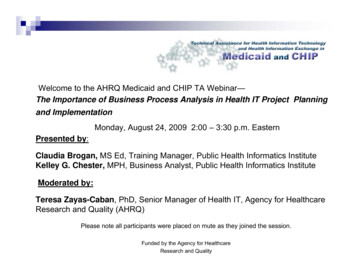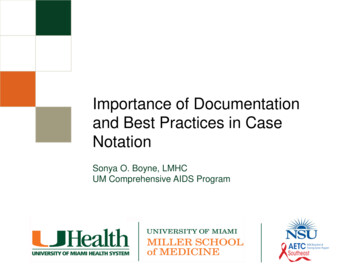
Transcription
Importance of Documentationand Best Practices in CaseNotationSonya O. Boyne, LMHCUM Comprehensive AIDS Program
Objectives:1.To demonstrate how the case note is used to provide programaccountability2.To demonstrate how the case note is used to indicate clientprogress3.To reinforce the importance of timely, concise, accurate,standardized case notes as a “best practice” in client care
OBJECTIVE 1:To demonstrate how the case noteis used to provide programaccountability
OBJECTIVE 1: PROGRAM ACCOUNTABILITYWhy Is It Important to Document?“Case Notes are legal documents which may be viewed by judges,attorneys, clients, etc. They provide a measure of protection andsubstantiate compliance with auditors.”Accurate record keeping provides accountability to the Client Organization Funder
OBJECTIVE 1: PROGRAM ACCOUNTABILITY“Social work case management is a discipline within the field of social work ”National Association of Social Workers Guidelines (http://socialworkers.org/)3.04: Client RecordsSocial workers should take reasonable steps to ensure that documentation in recordsis accurate and reflects the services provided.Social workers should include sufficient and timely documentation in records tofacilitate the delivery of services and to ensure continuity of services provided toclients in the future.Social workers' documentation should protect clients' privacy to the extent that ispossible and appropriate and should include only information that is directly relevantto the delivery of services.Social workers should store records following the termination of services to ensurereasonable future access. Records should be maintained for the number of yearsrequired by state statutes or relevant contracts.
OBJECTIVE 1: PROGRAM ACCOUNTABILITYPURPOSES OF RECORDSAccurate record keeping supports the case manager in planning,implementing, and evaluating services for each client illustrates patterns of in/effective interventions enhances quality of service – Especially with heavy case loads or incrisis situations follows the agency/organization/state or other governing bodyprotocols and these are followed in the charting. reflects any significant client, family or secondary service providercontact measures outcomes reminds Case Manager of services to be provided serves as support for insurance coverage purposes presents accurate history of crisis patterns
OBJECTIVE 2:To demonstrate how the case noteis used to indicate client progress
OBJECTIVE 2: CLIENT PROGRESSProgress Notes:Must prove “delivery of service” with information which is onsistentsubstantivepertinent
OBJECTIVE 2: CLIENT PROGRESSProgress Notes, cont’d:Always include: WHO: the name, qualifications and/or title of the qualified staff providing the serviceor intervention. WHAT: what was done, the specific interventions/skills training services provided WHERE: the physical site where were the services provided (office, client’s home,etc.). WHEN: date, length of service (in units and time) and time of day. WHY: why the services were done. The intended goal, objective and outcome relatedto the interventions/skills training services. HOW: how the interventions were done (concrete, measurable & descriptive) alongwith the client’s response and progress.
OBJECTIVE 3:To reinforce the importance oftimely, concise, accurate,standardized case notes as a“best practice” in client care
OBJECTIVE 3: STANDARDIZATIONRyan White Program Medical Case Management Record Review ToolRevised 6/23/2017PROGRESS NOTESYESDid MCM document a clear explanation of the following in the FA/CHA progress note:1Reason for interaction with the client2Client needs, if any3Client's unique circumstances or changes since last assessment4Client's current disease status5Action taken to address the needs and or intervention performedon behalf of the clientPROGRESS NOTESYES
OBJECTIVE 3: STANDARDIZATIONDocumentation Format Styles S-O-A-P: Subjective, Objective, Assessment, Plan G-I-R-P: Goal(s), Intervention(s), Response(s), Plan D-A-P: Data, Assessment, PlanConsistency is the Key!
OBJECTIVE 3: STANDARDIZATIONDocumentation Format StylesG-I-R-P: Goal(s), Intervention(s), Response(s), Plan:Goal/objective is being worked on (from POC)Intervention used (reviewed, coached, prompted,assisted, encouraged, etc.)Response of the client (feeling and/or action words)Plan for next steps (next visit, client will, client plansto )
OBJECTIVE 3: STANDARDIZATIONDocumentation Format StylesG-I-R-P Note Sample:(G) MCM met with client at her office for the purpose of updated herPlan of Care.(I) MCM conducted Financial assessment and ComprehensiveHealth Assessment. MCM screened client for needs to beaddressed.(R) Client communicated about concerns in getting her newprescriptions filled. Client appeared slightly anxious as evidenced byher “getting up and looking out the window."(P) MCM will generate certified referral for client to pick upprescribed medications. Client will pick up new medications withinthe next three days.
OBJECTIVE 3: STANDARDIZATIONDocumentation Format StylesD-A-P: Data, Assessment, PlanData: What did the client say during the visit? What did youobserve during the visit? Include both non-verbal andintuitive senses.Assessment: What is going on? How does the clientappear? What is their mental/physical state? Include bothnon-verbal, working hypotheses, and gut hunches abouthis/her situation.Plan: Response or revision to his/her overall situation; nextvisit date, any topics to be covered next session, etc. Whatis your plan of action; what are you (or the client) going to doabout it? What is your follow-up plan with the client?
OBJECTIVE 3: STANDARDIZATIONDocumentation Format StylesD-A-P Note Sample(D) Clinic-visit with client to complete and update care plan. Client spentmost of the visit talking about her medications. She mentioned that she getssick often and suffers from nausea from time to time for no apparent reason.She said she has tried to follow the directions given by the doctor, but isconcerned about the recent weight loss she has had and wonders if it is dueto the medications.(A) Client fidgeted, talked fast, and seemed stressed over her medicalcondition. During the visit she spoke little about her family life, she seemedto be more preoccupied with having her meds changed and getting past thenausea. Not much improvement from her last visit.(P) Will follow up with client to ensure she relates info to her doctor duringher next visit and refer for adherence counseling until client feels better.Continue to work with client on adherence.
OBJECTIVE 3: STANDARDIZATIONDocumentation Format StylesS-O-A-P Note Sample(S) Client reported difficulties in keeping appointments with providers including thiscase manager, ADAP, and the doctor. Client expressed concern with memory issuesand transportation challenges.(O) Client was polite and joking throughout meeting. He was neatly dressed, wellspoken but had to stop to think about what he was saying as he had trouble stayingfocused.(A) Client is at risk of being non-adherent to medications and other appointments.Client needs reminders to assist with keeping appointments, a pillbox to help withmedication adherence and help with transportation.(P) Provide client with a pillbox and have nurse in clinic assist in setting it up. Provideclient bus tokens to assist in getting to appointments. Call client 24 hours prior to visitwith case managers as a reminder.
OBJECTIVE 3: STANDARDIZATIONDocumentation Format StylesS-O-A-P: Subjective, Objective, Assessment, PlanSubjective Data: information from the client, such as the client's descriptionof pain or the acknowledgment of fear. Including subjective input from theclient in his participation in the plan of care. Appendix 3 O –Objective Data: data that can be measured. Laboratory data, observationsof appearance or home environment, and making appointments withproviders are sources of objective information.Assessment: an interpretation of the client's condition or level of progress.The assessment determines whether the problem has been resolved or iffurther care is required.Plan(s): may include specific orders designed to manage the client'sproblem, collection of additional data about the problem, individual or familyeducation, and goals of care.
OBJECTIVE 3: STANDARDIZATIONGeneral Professional GuidelinesThings to include: Highlighting the client’s strengths, supports and coping mechanisms Specification of where the information came from (ie client reports/states,as per medical report) Client’s identification on each page Documentation of the link of successes and failures to the service plan Tracking of client activities (job pursuits, assessments, etc.) Tracking of program/agency monitoring activities (contacts, lab results,etc.)
OBJECTIVE 3: STANDARDIZATIONGeneral Professional GuidelinesThings to avoid: casual abbreviationstaking shortcuts at the cost of clarity (re-read out loud)generalizations or over-interpretationsgrammatical errorsnegative, biased, and prejudicial language.details of the client’s intimate life unless it is relevant to care plan.use of medical diagnoses that have not been verified by a medicalprovider (ie rather than “the client is depressed”, say, “client states thathe is having feelings of sadness or depressed mood” or “client describesseeing hallucinations or feeling sad on a daily basis”
OBJECTIVE 3: STANDARDIZATIONGeneral Professional GuidelinesTips and Suggestions: Stay organized Carry notepad Maintain encounter log Account for “case noting” time Save time to document Secure time to document Utilize staff resources to improve
PRACTICE AND ASSESSMENTCase Note DocumentationPractical Application
PRACTICE AND ASSESSMENTWhich best meets criteria for a well-writtennote?
PRACTICE AND ASSESSMENTSelf Check:Did your note prove “delivery of service” with information which isaccurate, timely, objective, specific, concise, descriptive, consistent,substantive, pertinent? Give a reason for your interaction with the client?Indicate any client needs?Indicate any changes in client status since last assessment / encounter?Address client’s current disease status?State action taken on the client’s behalf?
PRACTICE AND ASSESSMENTCorrect these notes to better meet criteria
PRACTICE AND ASSESSMENTSelf Check:Did your note prove “delivery of service” with information which isaccurate, timely, objective, specific, concise, descriptive, consistent,substantive, pertinent? Give a reason for your interaction with the client?Indicate any client needs?Indicate any changes in client status since last assessment / encounter?Address client’s current disease status?State action taken on the client’s behalf?
Q&A
PRACTICE AND ASSESSMENTResourcesGuidelines for Social Work Case Management Documentation. National Association of SocialWorkers. Retrieved May 25, 2018 from www.socialworkers.org.Care Plans. ACT. Retrieved May 25, 2018 from www.ctaidscoalition.org/pdf/cmti/care plans.pdf.Florida HIV/AIDS Case Management Operating Guidelines. Florida Department ofHealth. Retrieved June 19, 2018 from s/aids/patient-care/ ltmann, T. (2015, April 24). Intro to Case Notes for new social workers. OER Commons.Retrieved June 19, 2018, from case-notes-for-new-social-workers.Case Management and Writing Effective Case Notes. Experience Works. Retrieved June 19, 2018from http://www.experienceworks.org /site/ DocServer/Case Management Writing Effective Case Notes.pdf?docID 23124.
This Presentation and resources aremade possible by AETC grant awardU1OHA29295 from the HIV/AIDSBureau of the Health ResourcesServices Administration (HRSA), U. S.Department of Health and HumanServices (HHS).The information presented is theconsensus of HIV/AIDS specialistswithin the SEAETC and does notnecessarily represent the official viewsof HRSA/HABThe AIDS Education andTraining Center (AETC)Program is the training arm ofthe Ryan White HIV/AIDSProgram. The AETC Program isa national network of leadingHIV experts who provide locallybased, tailored education,clinical consultation andtechnical assistance tohealthcare professionals andhealthcare organizations tointegrate high quality,comprehensive care for thoseliving with or affected by HIV.
Florida Counties
The U.S. Department of Health and Human Services(DHHS) has released updated versions of itsantiretroviral treatment guidelines for adults andadolescents, and for children with HIV. The new adultguidelines include revised recommendations for firstline antiretroviral therapy (ART) as well asmanagement of treatment-experienced patients. Therevised pediatric guidelines include a discussion of veryearly treatment for HIV-infected infants.ReferencesHHS Panel on Antiretroviral Guidelines for Adults and Adolescents.Guidelines for the Use of Antiretroviral Agents in HIV-1-Infected Adultsand Adolescents. Updated April 8, 2015.DHHS Panel on Antiretroviral Therapy and Medical Management of HIVInfected Children. Guidelines for the Use of Antiretroviral Agents inPediatric HIV Infection. Updated March 5, 2015.
TRAINING OPPORTUNITIESPreceptorshipsAn intensive clinical training program offered to healthcare providers in Florida who havean interest in learning more about the diagnosis and management of HIV/AIDS,opportunistic infections, and co-morbid conditions. Each preceptorship is structured tomeet the unique needs of the individual participant based on his or her previousexperience, geographic location, and time available. Experience 4 to 240 hours of clinicaltraining at adult, pediatric, obstetric, and/or family practice clinics where care is providedto HIV-infected patients. All training provided is consistent with current guidelines from theDepartment of Health and Human Services or other nationally recognized guidelines whenavailable.Clinical ConsultationIndividual and group clinical consultations are offered. Individual clinical case consultationis provided on the diagnosis, prevention, and treatment of HIV/AIDS and relatedconditions. These consultations take place by telephone, email or face-to-face meetings.Group clinical consultation with case-based discussions include information onpharmacology, clinical antiretroviral therapy updates, drug-drug interactions, andantiretroviral resistance.
FOR MORE INFORMATION, partners/seaetc
National HIV/AIDS Clinicians’ Consultation CenterUCSF – San Francisco General Hospital800.933.3413National HIV/AIDS Telephone Consultation ServiceConsultation on all aspects of HIV testing and clinical careMonday - Friday9 am – 8 pm ESTVoicemail 24 hours a day, 7 days a week888.448.4911National Clinicians’ Post-Exposure Prophylaxis HotlineRecommendations on managing occupational exposures to HIV and hepatitis B & C9 am - 2 am EST, 7 days a week888.448.8765National Perinatal HIV Consultation & Referral ServiceAdvice on testing and care of HIV-infected pregnant women and their infantsReferral to HIV specialists and regional resources24 hours a day, 7 days a weekHRSA AIDS ETC Program & Community Based Programs, HIV/AIDS Bureau& Centers for Disease Control and Prevention (CDC)www.nccc.ucsf.edu
Need Additional Information?Contact the South FL SE AIDSEducation and Training CenterVenada Altheme, Program Manager:vla33@med.miami.eduTivisay Gonzalez, Program Coordinator:tgonzalez1@med.miami.edu
Thank you!
Jun 27, 2018 · 1.To demonstrate how the case note is used to provide program accountability 2.To demonstrate how the case note is used to indicate client progress 3.To reinforce the importance of timely, concise, accurate, standardized case notes as a “best practice” in client careFile Size: 1MB


